After visiting the “Downtown Markham” site last Saturday, I went on to the old village of Markham. What’s interesting is the lack of current development here, even as Markham is booming, and some of the quirky heritage features, such as forced heritage-style structures and a heritage subdivision just to the north.
Old Markham has a few antique dealers, sports and hobby shops, the obligatory bank branches, cafes and bars, and is charming, if not unique. Markham Road/Highway 48 through here is forced into two general traffic lanes, yet there is still a lot of through traffic, despite the construction of a by-pass alternative to the east. (Unionville, smaller and with an even narrower roadway was completely bypassed with a re-routing of Kennedy Road.) The railway station was also preserved, and despite the lack of parking space, GO Transit continues to stop here. Recent GO Stations, such as Mount Pleasant, Lisgar, and Rutherford, attempt to look like old railway stations (and in the middle of giant parking lots), but don’t do nearly as well as the originals, such as Markham, Aurora, or Brampton.
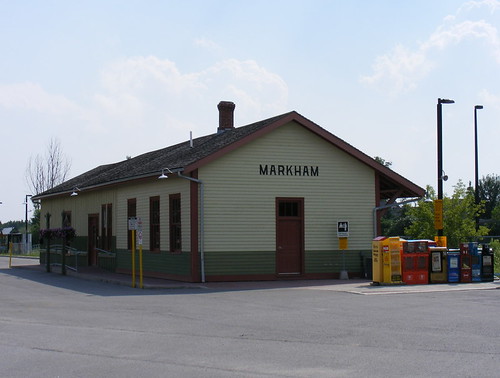 The simple, historic Markham station, original to the 1870s construction of the railway.
The simple, historic Markham station, original to the 1870s construction of the railway.
But what’s also interesting are the attempts to recreate the Victorian streetscape in newer buildings in and around the old village. Especially comical was the Esso gas station, built to full suburban size, but with a wooden blue-white-and-red sign and a brick veneer on the poles and buildings, with wood shingles. A throwback to the earlier gas stations with art deco canopies and replica signage would have been better.
 A rather decent attempt at recreating a historical building to fit in the old business centre.
A rather decent attempt at recreating a historical building to fit in the old business centre.
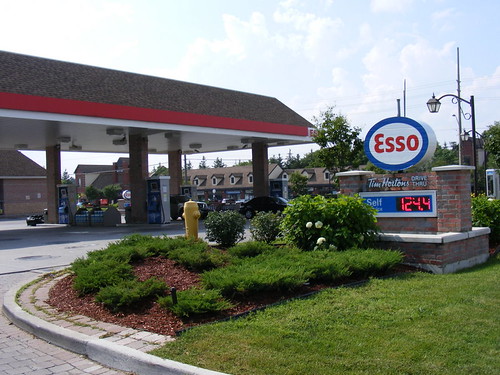 An amusing fake-historist gas station near old Markham.
An amusing fake-historist gas station near old Markham.
But the strangest heritage effort in Markham is the Markham Heritage Estates subdivision. This small subdivision is owned by the Town of Markham and is a place for historic houses to be moved to if they are threatened by development and unable to be preserved in place. But seeing these Victorian and Edwardian houses together, where farmhouses stand next to buildings that once stood in one of the original villages, in a modern subdivision layout, looks like something out of an early Tim Burton film.
 A house recently moved to the subdivision and not yet renovated.
A house recently moved to the subdivision and not yet renovated.
 Nearby, the Markham museum preserves non-residential buildings, such as the old Locust Hill CP Station, used until the cancellation of VIA Peterborough service in the infamous Mulroney 1990 axe of passenger rail. All three railway stations in Markham have been preserved, with Markham station still in active service.
Nearby, the Markham museum preserves non-residential buildings, such as the old Locust Hill CP Station, used until the cancellation of VIA Peterborough service in the infamous Mulroney 1990 axe of passenger rail. All three railway stations in Markham have been preserved, with Markham station still in active service.

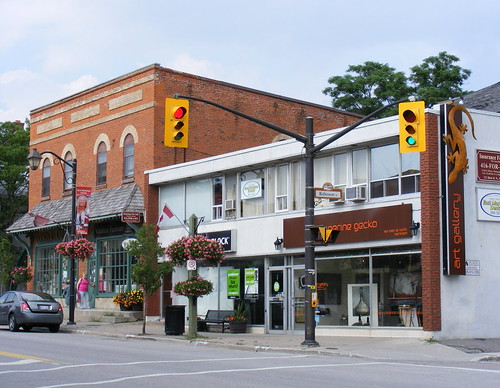
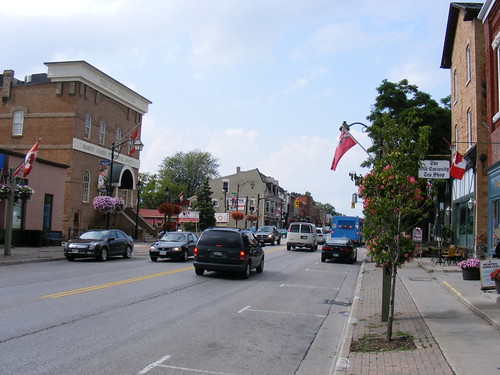

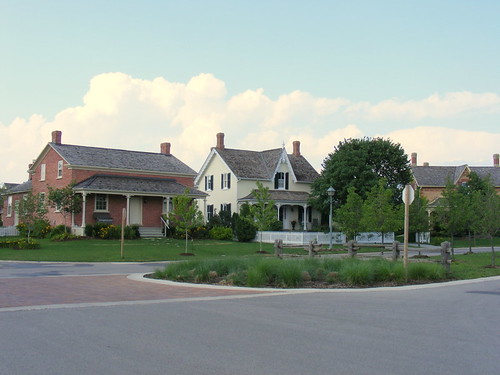
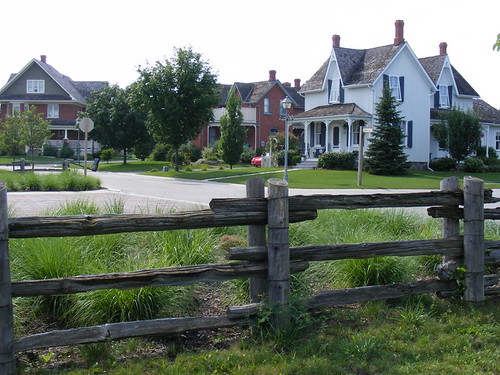



26 comments
Well now that Flaherty and del Mastro seem to be getting their way on Peterborough, maybe Locust Hill will get its station back?
As strange as the Markham Heritage Estates might look, most of those houses would have been bulldozed or torched without a second thought of saving them. This fate has befallen some of the old farmhouses of north Oakville, but I understand that some effort is being made to preserve the remaining ones in the same way that Markham did. It would have been desirable to leave them in place to add some authentic character to a new development, however developers of the past saw no value in doing so, and were only to happy to have those old houses disappear from their development sites. This has been going on for a century, but at least now there is some recognition of the value of saving these houses when their condition warrants it.
Great posts Sean.
Love the faux gas station. My grandfather owned the original one in Unionville on the corner of Main and No 7 back in the day. It was basically a block house. Poor block houses, nobody wants to preserve them.
We got a good laugh when they put in one of these faux traditional stations. Yes, so traditional–where the hell did they repair the cars?
It boggles the mind that subdivisions are built with poorly executed faux-heritage architecture, while the original farmhouses are demolished or moved from the sites. It’s just so mindless.
This area won’t succeed for two reasons: the bottom is going to fall out of suburban real estate and leave Markham half finished for decades, and people who live there will own cars and not live as an urbanite does.
If you look at a succesful neighbourhood in Toronto, it’s invariably pre-war: designed before full automobile penetration. Some of these exist in the 905, but have been ruined by automobile ownership. A neighbourhood loses vitality once a certain majority of residents have cars to get around; it keeps it if a certain number don’t. Intensification in Markham and Mississauga will not work, because the people who’d buy there are already car owners. They can easily drive elsewhere to shop, work and entertain, and will. What keeps pre-war streets vital in the old city of Toronto is the fact that a large number of residents do not have a car, and expect their neighbourhood to satisfy their needs, and it does.
The Markham Heritage Estates mix of housing reminds me of Preservation Park in Oakland, California which has turn of the last century housing that would have been demolished. The houses are leased to environmental and social businesses and nonprofits.
Cooksville (now part of Mississauga) used to be a quaint village with a railway station near Dundas and Dixie. Instead of preserving the Cooksville identity, they widened the roads, put in parking lots, and now Cooksville looks like any other suburban cookie-cutter neighbourhood (if it could be called that).
I invite jamesmallon to come by my “vital” Toronto neighbourhood and drive the crack addicts out of my car port.
Canada was a very different place when they couldn’t even afford to build their stations with brick. What is the significance of Markham station’s odd paint job?
‘i’, there’s always a trade-off. You can choose to move to the 905 and live only with people of your own class.
Anyway, the solution to the crack addicts is to bring back, and improve, the addiction and mental health services that we once had. Instead, Tory governments gutted that health sector, voted for by 905 people who do not have to live with the consequences.
Mikeb: The classical gas station I would expect would either be something out of a Edward Hopper painting, but at least larger – though there’s a few old Texaco stations around, like on Highway 7 in Norval, that have been privately preserved. Niagara-on-the-Lake is certainly bad for this kind of thing as well.
Epimetheus: The Markham station was built in the 1870s by the little Toronto and Nipissing Railway, which ran only to Coboconk and built on a shoestring. Since its primary purpose was resource extraction – lumber, agriculture, and quarried stone, passenger services were an afterthought (though the station in Uxbridge was upgraded later on). A similar station still exists on site in Unionville, but GO decided to build a new station south of 7 with lots of parking instead of serving the old one. At least they still served Markham, even with the new Mount Joy station and its parking.
I believe the colours represent the old Grand Trunk corporate colours, which bought the T&N (and later became part of CN).
There has been at least one example of Markham maintaining a heritage house within a surrounding subdivision, at William Berczy Blvd. and Drawbridge Dr.
http://tinyurl.com/5smuen
Perhaps the main problem with Markham Heritage Estates is the inherent danger of this being seen and embraced as an *ideal* heritage solution, rather than an creatively convenient emergency measure–that is, you create a “heritage subdivision”, and developers and whomever will treat it as a smiley-face dumpster for those pesky old wrecks they can’t be bothered preserving. An architectural version of Springfield Retirement Castle.
Sean–Thanks. I do go through Norval once in awhile. I will check it out.
jamesmallon–I would quibble with your belief that a certain majority of residents’ car ownership phohibits a successful neighbourhood. Neighbourhoods like the Beaches, Bloor St W, North Toronto, and Bayview/Leaside (btw Davisville and Eglinton) likely meet your definition of success. They all have very high car ownership rates.
jamesmallon, I did move to the 905 (Oakville), not to “live with my own class”, but to afford a decent house that was livable.
Did you know they stack your emptied recycling bins neatly on your yard after collection out here? And that the pools are all open, water fountains work, and kiddie splash areas are turned on in June? And our trees aren’t dying in concrete, either!
Enjoy your mega-city!
“Enjoy your mega-city!”
We do, and that’s why we comment on a blog about Toronto. The fact that the people who comment on this blog don’t like the suburbs much shouldn’t really surprise you.
Well put, ‘bbpsi’. That I felt myself dieing inside living in the suburbs would mean nothing to someone who likes it. Go figure. I know what I like, having lived in Georgetown, Brampton, Guelph, Toronto, Montreal and Tokyo, and the ‘burbs it isn’t.
This doesn’t sounds nice, but I think it will say more about those sensitive to it: I do not find people from suburbs interesting, more often than those from cities. I suppose they’d say the same about me and mine, and they are welcome to. It’s a two-solitudes thing.
I will take issue with suburban blanket statements about the perils of the city, because… the crime-rate is often much lower than in much of the 905, an urbanite has a far smaller environmental footprint, and automobile suburbs are nearing an inevitable end (train-‘burbs, such as are left, have a long and hopeful history).
It is cheaper to buy a house in the ‘burbs, as ‘i’ says, but not as cheap as you think, once you have to run one or two extra cars in the family ($8000/yr each on average: two fewer cars means you can carry $250K more mortgage). Never mind the longer commutes taking time from your family and leisure.
there are a number of heritage houses that have been incorporated into subdivisions in Markham
here are a few examples:
1 Kalvinster Drive (renovating)
33 Artisan Trail
15 Bewell (renovating)
7 Bewell (renovating)
95 Russell Jarvis Drive
29 James Walker Court (renovating)
66 Monique Court (renovating)
25 Burr Crescent
60 Meadowbrook Lane
among others…(some are under renovations while others are fully incorporated into subdivions)
it seems as though markham has kept many of its heritage houses/structures in place. Heritage Estates is an attempt to save only those that are threatened by development, and this is better than having the heritage homes demolished.
I owned one house in the markham heritage estate. Most of the owners here love the special of our house. We have to go through so many applications approve in order to relocate and restore the house. I love my house and so do all my neighbors in this sub-division. We feel proud to make effort to preserve the old houses. I would rather spend money on gas rather than move to a small house i can see my neighbor in any window of my house. Or a lot with a large indoor but only few foot of outdoor. Suburban has its own value and so do city too. I was living in high rise modern city for many years. I appreciate the peaceful i have right now in sub-urban.
Dear Sean,
We have the opportunity to build a “new old house” in the Village of Markham.
Interesting to find the article on the “Old Downtown”. A building lot exists a few streets east of the Main St. We are wondering wether we should proceed. When building in this little corridor, Markham’s “Heritage Committee” oversees the plans so they conform to certain architectural standards.Our fear is that Markham’s city council is putting all it’s energies into the “New Downtown”
The Main St Village looks as if it’s dwindling, no efforts to stimulate. We are becoming so worried about what would be a long term investment. Really wondering if Downtown T.O. is the way to go. After reading your articles I see
a potential ghost town, with all the energies in place for the new downtown.
We pictured a quaint home in the village where our daughter could walk to High School, I could walk for groceries and set up a fitness studio.Do you have any other comments after visiting both the old and new downtowns, what are your thoughts if you have any on the matter. It would be greatly appreciated.
M.C.
Maryann, I have been a resident of the Markham suburb for many years (>25), lived on a farm and also in a major downtown area. I believe I understand the small town atmosphere you want, but I do not think you will find this anymore in Markham Village(please suburbanites , do not bash me) . The main street area has languished for many years, and you really cannot walk to do much, even with trucks supposedly banned on the street. the cornell experiment (new urbanism) was supposed to create a walking-friendly area, but here again everyone has a car and there have been problems with parking. Stores in that area come and go. Development continues and there is ever increasing strains on infrastructure. Main St unionville has some small town atmosphere, but is quite pricey and the High school is not ‘walkable’.
Commuting is an issue, whether you drive, or take GO transit. I understand the issues with inner city living , and this makes the burbs seem nicer in some ways, however, we are considering a move back into the city or to a real ‘small town’, not a bedroom community. We were considering Stouffville, however it is deep in the throes of massive development so I am not certain how long it will retain the small town feel.
A couple of points to be aware of
1) Of the 28 buildings in the Markham Heritage Estates 8 were relocated from the Highway 407 Corridor or other upper-tier road construction where through either provincial exemption from designation the Municipality had no power to force the Province to move the highway preserve the houses at or adjacent to the original site. In any other municipality these would have been all lost.
2) 12 of the buildings were in extreme states of neglect prior to relocation to a point where they would have been condemmed, and there was also no prospect of imminent development of these property in which restoration of the property could be required) on the horizon. Only recently have municipalities been given the power to prescribe special heritage standards of maintenance which protect the heritage building in addition to public safety. In any other municipality these buildings would have been lost.
3) 2 of the buildings were relocated from Richmond Hill which takes in part of former Markham Township. These were allowed to be demolished by the Town of Richmond Hill, however Markham considered these to be of such Regional Signficance (e.g. original pioneer homesteads dating back to the 1820s) that it allowed these to be relocated here.
4) One building was already on the site as the original farmhouse.
5) Only 6 buildings actually came from sites where there was active development proposals. In 3 of those cases the developers were required to conserve another more significant heritage home within the development site (one developer had to preserve Three). Of the remaining three, one was in a big box development site, one was at a service station site and the last had unusual personal circumstances attached to it which Council had to consider when looking at the bigger picture. I think its clear that the heritage estates is not a dumping ground for developers.
6) Until 2005 the Ontario Heritage Act did not require permanent protection of heritage resources. Developers could just wait 180 days and demolish.
7) Markham has probably the best record in the GTA of preserving heritage buildings within development sites. Am aware of at least 22 that were preserved in plans of subidvision/new developments between 1995 and 2005.
No significant heritage resources were lost in developments over this period with the exception of a handful which were destroyed by fire or demolition without a permit while conservation was being negotiated.
8) The unusual subdivision layout was created because a)it better facilitated the relocation of the houses to the lots and b)the houses were rural farmhouses, and the layout allowed for more spacing around the houes as would have been seen in their original contexts. Its not perfect but there really was no precedent for this sort of thing.
8) Markham Heritage Estates is not the perfect solution for preservation by any means. Preservation on-site should alwasy be pursued as the first option. It was however a solution that worked specifically for Markham in the circumstances it was facing at the time. In Ontario up until 2005, no heritage building was permanently protected. The Heritage Estates was a unique solution created by a municipality which desired to preserve its rural heritage in the face of massive development and highway construction, but with the full knowledge of the inadequacies of the Heritage legislation at that time.
Fortunatley the stronger Ontario Heritage Act introduced after 2005 means that the necessity of a municipality setting up a heritage subdivision like this is far less today than it was in 1989 when the Heritage Estates was established.
There are still significant threats. Its amazing how fast a heritage building can be run down to the point where it is either move it or lose it, as the latest example to move into the heritage estates shows, but the lot of heitage resources in Ontario is improving.
Today Markham has 28 beautifuly restored heritage homes (and one about to be resored) which serve as an inspiration to conservation efforts elswhere in the municipality. Because the Town can require proper restoration techniques, the project has kept alive in Markham many of the unique skills and trades that are necessary to maintian and restore these homes, a spin-off which other heritage homes located elsewhere in the municipality have benefited from.
Had any of these 28 buildings been located in other munciipalities and facing similar threats at the time. None would have been conserved. The Markham Heritage Estates is odd, flawed and unusual but it is certainly better than the alternative.
I hope this helps make everything clear.
I wish Markham have a commitment to traffic flow as they do with Heritage estate preservation. In order to keep everything looking “just so” they refuse to widen the roads and update the bridge. Through the olde town you have modern day traffic congestion and a great deal of pollution due to a great deal of idling. Forcing two lanes of heavy traffic into one, going over a stone bridge.
The ironic thing about this is that it’s the Markham Environmental Assessment Community Advisory Group that are blocking the improvements!
Michael, thank you for your comments. We should be grateful to the Lunau family for donating the land for Markham Heritage Estates and that Markham has made some strides in perserving the heritgage of Markham. It is not an easy process for someone to move a house into Heritage Estates, many loopholes to go through, etc.
As a historian for the Breuls family, who resided in Ringwood, previously part of Markham, I have watched the majority of the historic homes demolished for way of development.
A few years ago, several homes were demolished to make way for Walmart. These were homes of settlers in the 1820’s & 30’s.
I was involved in providing historical information that allowed one of the two remaining Breuls farmhouses to be relocated to Heritage Estates. It would have been a shame that due to development, a family that was such a part of the history of Ringwood would have been lost.
You drive down Highway 48 from Stouffville Road and there is very little left of Ringwood or the families that lived there for so many years.
We are interested in moving a historic house to a lot in Goderich On and restoring it. Does anyone know how we could find a house to move?
We don’t know where to start.
Thank you
jdear@hotmail.com